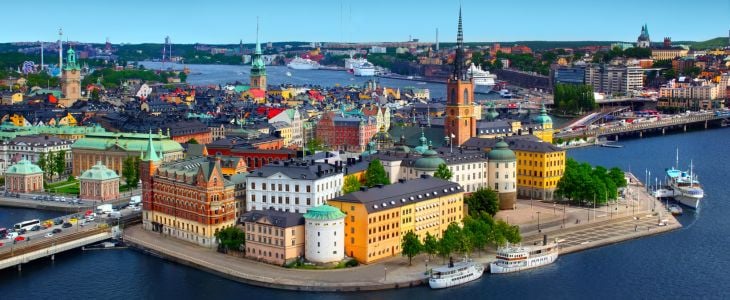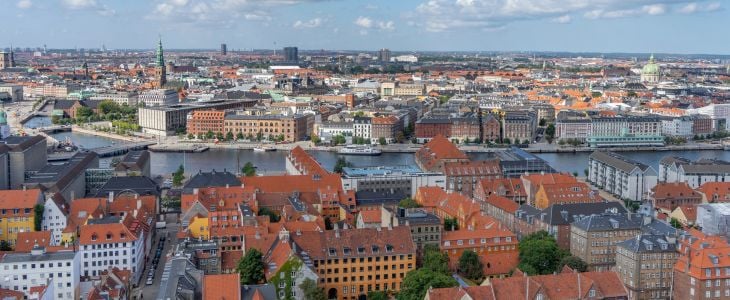The increasing integration of district heating in Europe is directly linked to the current environmental challenges in the continent and beyond. In the quest for sustainability, district heating has emerged as a pragmatic solution effective at reducing carbon emissions and fostering responsible energy practices.
By embracing district heating, Europe takes a tangible step toward a greener future, one where efficiency and renewable energies are part of a successful formula.
This transition towards green district heating in Europe is particularly urgent considering that heating and cooling represent around half of the EU’s energy consumption, while renewables only currently provide 23% of consumption in the heating and cooling sector (Eurostat 2021).
As such, district heating stands out as a solution to decarbonise the sector and allow for the increasing implementation of renewables. District heating, a promising technology,is already leading outstanding initiatives in sustainable construction and beyond.
Let’s thus analyze the crucial role of district heating in Europe, today and in the future.
The importance of district heating in Europe
Official authorities at the European Union are actively advocating for district heating and its key role in a more sustainable Europe.
While both private and public operators seek to fulfill the EU’s climate and energy goals, papers such as ‘Advancing district heating & cooling solutions’ by the Publications Office of the EU describe district heating and cooling (DHC) a “a proven solution”. As we’ll see below, this advocacy has also translated into crucial district heating regulation.
The environmental advantages of district heating are behind this preference:
- Offers increased energy efficiency
- Facilitates the integration of renewable and waste heat sources
- Contributes to the reduction of carbon emissions
- Fosters local economic development and local energy sources
- Enhances energy security
In fact, initiatives such as the Heat Roadmap Europe put district heating at the heart of achieving net zero emissions in Europe. This project’s research has calculated the development of 21,500 new district heating systems (as well as the investment in sustainable construction) can lead to a fully decarbonized heating landscape in 2050.
Current consumer perceptions around district heating in Europe
Consumer preferences and attitudes towards district heating in Europe are also key to understanding this crucial part of the heating sector in the continent. Crucial data has been gathered by Billerbeck et al. (2024) BY 4.0, in a paper conducted to analyze precisely this matter via a survey with 4,388 participants from nine European countries. Two key takeaways can be gathered from this research:
- A majority of respondents (52%) consider district heating in Europe to be a positive or even very positive development. Among the countries that were included, opinions are particularly positive in Denmark and Sweden.
- Different district heating regulation initiatives can have an impact on public perceptions around district heating in Europe.

District heating regulation in Europe
While district heating regulation in Europe varies by region and country, some of the most important norms revolve around the following topics:
- Specific environmental performance criteria, including limits on emissions
- Efficiency standards
- Requirements or obligations for buildings or communities to connect to available district heating networks.
- Pricing regulations, in an effort to ensure fairness and affordability for consumers. District heating in Europe shows a wide spectrum in this area, going from more regulated contexts to more liberalized approaches.
- Urban planning regulations
- Market regulations to avoid monopolistic practices
These regulations aim to manage a heating sector that presents its own idiosyncrasy, as it's often vertically-integrated (generation, grid and distribution are integrated). It’s important to note that regulation initiatives vary widely among countries’ frameworks, also leading to a multi-facetted European landscape that must be considered on a case-by-case basis. This nuanced approach must also be taken into account when it comes to public vs. private ownership in district heating in Europe, as well as mixed-ownership structures.
Successful implementations of district heating in Europe
The European continent includes some of the most successful nation-wide implementations of district heating around the globe.
Such is the case of Denmark’s district heating development, where approximately two thirds of households are connected to a district heating system. This has been paired up with an increasing reliance on renewable energy sources (now covering 60% of their electricity needs) and efficient industrial heat pumps.
District heating in Sweden has also been hailed as an example of a successful integration. The country has already reached the Kyoto protocol’s climate goals thanks to its focus on energy efficiency and low-carbon sources. With all major Swedish cities and towns presenting their own district heating infrastructure, the country has incorporated this approach to heating as part of their own successful blend towards decarbonisation.
The future of district heating in Europe
As the continent navigates a transition towards a more sustainable, efficient, and resilient energy landscape, district heating in Europe holds the key to important changes that are already shaping what the heating sector looks like today.

Optimistic projections and favorable regulations are translating into the shaping of the district heating of the future in the continent, which will very likely revolve around:
- The achievement of a flexible integration of a variety of renewable energy sources, with the aim of both becoming more sustainable and resilient. As foreseen by the Heat Roadmap Europe, a decarbonized District Heating landscape in 2050 could amount to a total of 1100 TWh/year with energy sources including CHP (38%), large-scale heat pumps fed by geothermal and other renewables (25%), recovered excess heat (14%), industrial excess heat (9%), geothermal (4%), solar thermal and wind (1%) Renewables would be also integrated
- The implementation of highly efficient equipment, including industrial heat pumps. These are particularly important in the decarbonization of heating: for instance, they are estimated by the IEA to have the potential to reduce global carbon dioxide emissions by at least 500 million tonnes in 2023. Financial incentives might become crucial in this area, which are already available today in a multitude of regions.
Other foreseeable trends in district heating in Europe include the digitalization and introduction of smart solutions to enhance efficiency; and the development of energy storage initiatives to address issues such as the intermittency of renewable energy sources.
All in all, as district heating initiatives incorporate increasingly sustainable and resilient measures, they remain a crucial development towards an environmentally-friendly heating sector.
At ARANER, we work to become allies in this development. As such, we’re involved in the advancement of cutting-edge district heating in Europe and beyond, putting our thermal engineering expertise to work and helping companies realize sustainable district heating initiatives.
From our industrial heat pumps to the design of district heating systems and TES tanks, we are involved in some crucial projects advancing an environmentally-friendly and efficient approach to district heating. All while guaranteeing each project makes the most of its own individual opportunities while by-passing its potential challenges.
Want to learn more about our projects and how we help companies achieve their goals? Get in touch with us and speak to our team.










